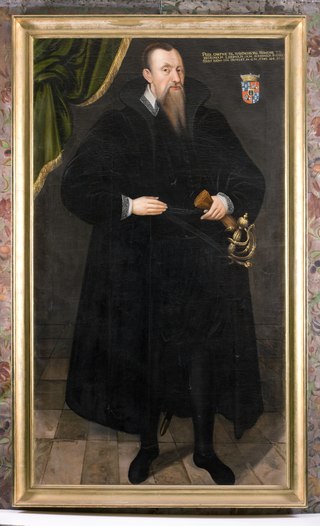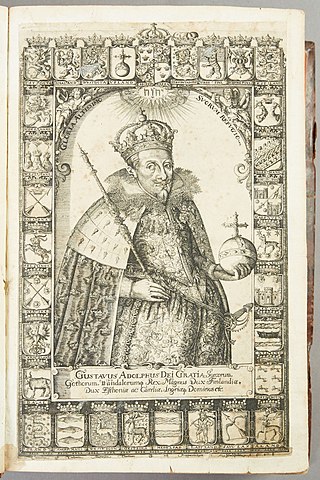
The Swedish nobility has historically been a legally and/or socially privileged class in Sweden, and part of the so-called frälse. The archaic term for nobility, frälse, also included the clergy, a classification defined by tax exemptions and representation in the diet. Today the nobility does not maintain its former legal privileges although family names, titles and coats of arms are still protected. The Swedish nobility consists of both "introduced" and "unintroduced" nobility, where the latter has not been formally "introduced" at the House of Nobility (Riddarhuset). The House of Nobility still maintains a fee for male members over the age of 18 for upkeep on pertinent buildings in Stockholm.

Uppland County, or Upplands län, was a county of the Swedish Empire from 1634 to 1641, and from 1654 to 1714. Between 1641 and 1654, and after 1714, it was split into the Uppsala County and the Stockholm County.

Ebba Magnusdotter Brahe was a Swedish countess, landowner, and courtier. She is foremost known for being the love object of King Gustavus Adolphus of Sweden, and because he wished to marry her prior to his marriage, plans which were however never realized. Their love affair has been famous in the Swedish romantic history and the subject of fiction, and are documented in their preserved correspondence.

The Duchy of Estonia, also known as Swedish Estonia, was a dominion of the Swedish Empire from 1561 until 1721 during the time that most or all of Estonia was under Swedish rule. The land was eventually ceded to Russia in the Treaty of Nystad, following its capitulation, during the plague, in the Great Northern War.

Per Brahe the Elder (1520–1590) was a Swedish statesman.

Göksholm is a medieval Swedish castle located on the southern beach of lake Hjälmaren. It is the oldest privately owned building in Sweden that has been continuously inhabited.
The Lord High Steward or Lord High Justiciar was a highly prominent member of the Swedish Privy Council from the 13th century until 1809, excluding periods when the office was out of use.
The creation and granting of counties and baronies in Finland began with the coronation of King Eric XIV in 1561 and continued through Great Reductions in the latter half of the 17th century.

Gustaf Banér was a Swedish noble, member of the Privy Council of Sweden.

The first duke of Estonia was appointed in 1220 by King Valdemar II of Denmark after the Danish conquest of Estonia during the Livonian crusade. The title was resumed by the kings of Denmark since 1269. During the 1266-82 reign of the queen dowager Margaret Sambiria, the title lady of Estonia was used.
Martha Eriksdotter Leijonhufvud, known as Kung Märta, was a politically-active Swedish noblewoman. She was the sister of Queen Margaret Leijonhufvud and sister-in-law of King Gustav I of Sweden: she was also the maternal aunt of Queen Catherine Stenbock and the daughter-in-law of the regent Christina Gyllenstierna. In 1568, she financed the deposition of King Eric XIV of Sweden, which placed her nephew John III of Sweden on the throne.
Ebba Månsdotter Lilliehöök of Kolbäck, was a Swedish noble, landlord and county administrator, Countess of Raseborg, Baroness of Gräfsnäs and lady of Käggleholm.

The Sture murders in Uppsala, Sweden, of 24 May 1567, were the murders of five incarcerated Swedish nobles by Erik XIV of Sweden, who at that time was in a state of serious mental disorder, and his guards. The nobles, among them three members of the influential Sture family, had been charged with conspiracy against the king and some were previously sentenced to death. Erik's old tutor, who did not belong to this group, was also killed when he tried to calm the king after the initial murders.
Ebba Mauritzdotter Leijonhufvud, also called Ebba Mauritzdotter Lewenhaupt, Countess of Raseborg, Lady of Käggleholm, Eksjöhovgård and Tullgarn, was a Swedish noble and courtier and member of the Leijonhufvud family. She served as överhovmästarinna in 1633–1634 and foster mother in 1639–1644 to Christina, Queen of Sweden. She was also known for her donations to various churches.

Amalia von Hatzfeld, was a Swedish countess. She was the governor of Raseborg in 1600–1607.

Per Gustafsson Banér, also known as Peder Gustafsson Banér was a Swedish nobleman and member of the Privy Council of Sweden.

Hogenskild Bielke was a Swedish baron, court official and riksråd. He was one of the more prominent leaders of the Swedish nobility in their power struggle against royal authority during the 16th-century.

Ekenäs Church is a 17th-century neoclassical stone church located in Ekenäs in the Finnish town of Raseborg. Construction began in 1651 and continued into the 1670s. The initiative to build a stone church in Ekenäs came from earl Gustaf Adolf Leijonhufvud but the designer of the original Baroque church is unknown.












